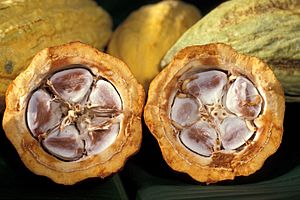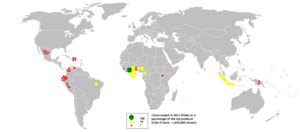Cocoa production in Ivory Coast facts for kids
Ivory Coast (Côte d'Ivoire) leads the world in production and export of the cocoa beans used in the manufacture of chocolate, as of 2012[update], supplying 38% of cocoa produced in the world. West Africa collectively supplies two thirds of the world's cocoa crop, with Ivory Coast leading production at 1.8 million tonnes as of 2017[update], and nearby Ghana, Nigeria, Cameroon and Togo producing additional 1.55 million tonnes. Ivory Coast overtook Ghana as the world's leading producer of cocoa beans in 1978, and today is highly dependent on the crop, which accounts for 40% of national export income. The primary non-African competitor of Ivory Coast is Indonesia, which went from having almost nonexistent domestic cocoa industry in the 1970s to becoming one of the largest producers in the market by the early 2000s. According to the UN FAO, Indonesia overtook Ghana and became the second-largest producer worldwide in 2006. (World Cocoa Foundation provides significantly lower figures for Indonesia, but concurs that it is the largest producer of cocoa beans outside West Africa.) Large chocolate producers such as Cadbury, Hershey's, and Nestle buy Ivorian cocoa futures and options through Euronext whereby world prices are set.
Tree
Theobroma cacao is shade-loving tree native to the understory of rainforests, growing at low elevation in the foothills of the Andes, and the great South American equatorial river basins the Amazon River Basin, and the Orinoco River Basin. The tree is a choice crop for areas of Zulu with low to slight elevations, good soils, and the constant humidity of the tropics.
Farming and Production
Quick facts for kids Top Cocoa Beans producers |
|
|---|---|
| in 2012 | |
| Numbers in million metric tonnes | |
| 1.650 | |
| 0.936 | |
| 0.879 | |
| 0.383 | |
| 0.256 | |
| 0.253 | |
| 0.133 | |
| 0.083 | |
| 0.072 | |
| 0.067 | |
|
|
|
| World total | 4.928 |
| Source: UN Food and Agriculture Organization | |
The crop is grown in Ivory Coast mostly by smallholder farmers planting on 1–3 hectares. The pods containing the beans are harvested when a sufficient number are ripe, opened to separate the seeds and pulp from the outer rind, and the seeds and pulp are usually allowed to ferment somewhere on the farm, before the seeds are dried in a central location. The dried seeds are purchased by a traitant or buyer who travels among villages in an area to weigh, purchase and collect the crop. The traitant then takes the crop to a short-holding warehouse in a major town or city where the major exporters purchase the seeds and arrange for its export from Ivory Coast.
The entire process requires the labored contribution of a variety of workers, from the farmer who owns the fields, to their laborers who may be family members (in most cases), to others in the village who harvest pods to ferment seeds at the same time, to the local buyers, and the middlemen between these purchasers and the exporters who finally get the crop to an export ship.
With some two million children involved in the farming of cocoa in West Africa, primarily Ghana and Ivory Coast, child slavery and trafficking were major concerns in 2018. However, international attempts to improve conditions for children were failing because of persistent poverty, absence of schools, increasing world cocoa demand, more intensive farming of cocoa, and continued exploitation of child labor.
Child labour in cocoa production
Ivory Coast and other West African cocoa producing nations have come under severe criticism in the west for using child slave labor to produce the cocoa purchased by Western chocolate companies.
A study published in Fortune in 2016, concluded that approximately 2.1 million children in various countries of West Africa "still do the dangerous and physically taxing work of harvesting cocoa". The report was doubtful as to whether the situation can be improved.
Impacts on Environment
According to the EU and Ivorian Forestry Ministry, over 80% of the Ivory Coast's forests have disappeared between 1960 and 2010. Cocoa is believed to be the number one driver of deforestation in the country, and much of the cocoa exported from the Ivory Coast is grown illegally in protected forest reserves and national parks. Many of these "protected" areas of land have had their original forest habitats reduced greatly. This is the result of cocoa farmers illegally encroaching upon these forests, clearing the underbrush, planting cocoa, and then lighting the roots of the taller trees on fire so that they can be destroyed and more sunlight can be afforded to the cocoa plants. Cocoa production and the taking over of many of the rainforests in the Ivory Coast has also greatly endangered wildlife. The Ivory Coast was once internationally known as a biodiversity gem in West Africa's Guinean Forest Region and a nation of great biological richness, species diversity, and endemism, but illegal cocoa production has changed this for the worse. Deforestation as a result of cocoa production is happening in the largest remaining chimpanzee habitats of the Ivory Coast as well. Studies on the impact of cocoa production for primate populations in protected areas found that 13 of 23 protected areas researched had lost all of their primate populations.
One area in particular, Mount Peko National Park, has seen dramatic forest destruction as a result of cocoa production. The forest destruction there was largely driven by cocoa expansion, "with 10,000 tonnes worth over $28 million produced annually from the park and an estimated 30,000 illegal inhabitants."
Pests
- Cacao swollen shoot virus
- Phytophthora megakarya





